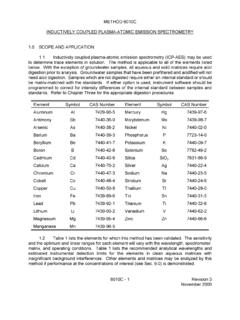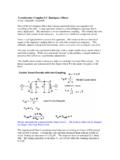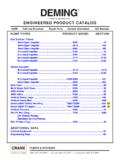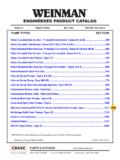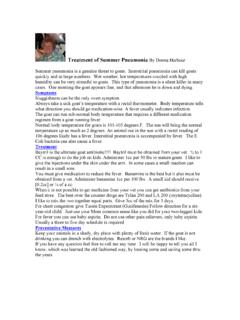Transcription of Method 200.8, Revision 5.4: Determination of Trace ...
1 1994 Method , Revision : Determination of Trace Elements in Waters and Wastes by inductively coupled plasma mass spectrometry Method Determination OF Trace ELEMENTS IN WATERS AND WASTES BY inductively coupled plasma - mass spectrometry Revision EMMC Version Long (Technology Applications Inc.), Martin, and Martin - Method , Revisions and (1990) Long (Technology Applications Inc.) and Martin - Method , Revision (1991) Creed, Brockhoff, and Martin - Method , Revision (1994) ENVIRONMENTAL MONITORING SYSTEMS LABORATORY OFFICE OF RESEARCH AND DEVELOPMENT ENVIRONMENTAL PROTECTION AGENCY CINCINNATI, OHIO 45268 Method Determination OF Trace ELEMENTS IN WATERS AND WASTES BY inductively coupled plasma - mass spectrometry SCOPE AND APPLICATION This Method provides procedures for Determination of dissolved elements in ground waters, surface waters and drinking water.
2 It may also be used for Determination of total recoverable element concentrations in these waters as well as wastewaters, sludges and soils samples. This Method is applicable to the following elements: Chemical Abstract Services Analyte Registry Number (CASRN) Aluminum (Al) 7429-90-5 Antimony (Sb) 7440-36-0 Arsenic (As) 7440-38-2 Barium (Ba) 7440-39-3 Beryllium (Be) 7440-41-7 Cadmium (Cd) 7440-43-9 Chromium (Cr) 7440-47-3 Cobalt (Co) 7440-48-4 Copper (Cu) 7440-50-8 Lead (Pb) 7439-92-1 Manganese (Mn) 7439-96-5 Mercury (Hg) 7439-97-6 Molybdenum (Mo) 7439-98-7 Nickel (Ni) 7440-02-0 Selenium (Se) 7782-49-2 Silver (Ag) 7440-22-4 Thallium (Tl) 7440-28-0 Thorium (Th) 7440-29-1 Uranium (U) 7440-61-1 Vanadium (V) 7440-62-2 Zinc (Zn) 7440-66-6 Estimated instrument detection limits (IDLs) for these elements are listed in Table 1. These are intended as a guide to instrumental limits typical of a system optimized for multielement determinations and employing commercial instrumentation and pneumatic nebulization sample introduction.
3 However, actual Method detection limits (MDLs) and linear working ranges will be dependent on the sample matrix, instrumentation and selected operating conditions. Given in Table 7 are typical MDLs for both total recoverable determinations by "direct analysis" and where sample digestion is employed. For reference where this Method is approved for use in compliance monitoring programs [ , Clean Water Act (NPDES) or Safe Drinking Water Act (SDWA)] consult both the appropriate sections of the Code of Federal Regulation (40 CFR Part 136 Table 1B for NPDES, and Part 141 for drinking water), and the latest Federal Register announcements. Dissolved elements are determined after suitable filtration and acid preservation. In order to reduce potential interferences, dissolved solids should not exceed (w/v) (Section ). With the exception of silver, where this Method is approved for the Determination of certain metal and metalloid contaminants in drinking water, samples may be analyzed directly by pneumatic nebulization without acid digestion if the samples have been properly preserved with acid and have turbidity of <1 NTU at the time of analysis.
4 This total recoverable Determination procedure is referred to as "direct analysis". For the Determination of total recoverable analytes in aqueous and solid samples a digestion/extraction is required prior to analysis when the elements are not in solution ( , soils, sludges, sediments and aqueous samples that may contain particulate and suspended solids). Aqueous samples containing suspended or particulate material 1% (w/v) should be extracted as a solid type sample (Section ). The total recoverable sample digestion procedure given in this Method is not suitable for the Determination of volatile organo-mercury compounds. However, for "direct analysis" of drinking water (turbidity <1 NTU), the combined concentrations of inorganic and organo-mercury in solution can be determined by "direct analysis" pneumatic nebulization provided gold is added to both samples and standards alike to eliminate memory interference effects.
5 Silver is only slightly soluble in the presence of chloride unless there is a sufficient chloride concentration to form the soluble chloride complex. Therefore, low recoveries of silver may occur in samples, fortified sample matrices and even fortified blanks if determined as a dissolved analyte or by "direct analysis" where the sample has not been processed using the total recoverable mixed acid digestion. For this reason it is recommended that samples be digested prior to the Determination of silver. The total recoverable sample digestion procedure given in this Method is suitable for the Determination of silver in aqueous samples containing concentrations up to mg/L. For the analysis of wastewater samples containing higher concentrations of silver, succeeding smaller volume, well mixed sample aliquots must be prepared until the analysis solution contains < mg/L silver.
6 The extraction of solid samples containing concentrations of silver >50 mg/kg should be treated in a similar manner. The total recoverable sample digestion procedure given in this Method will solubilize and hold in solution only minimal concentrations of barium in the presence of free sulfate. For the analysis of barium in samples having varying and unknown concentrations of sulfate, analysis should be completed as soon as possible after sample preparation. This Method should be used by analysts experienced in the use of inductively coupled plasma mass spectrometry (ICP-MS), the interpretation of spectral and matrix interferences and procedures for their correction. A minimum of six months experience with commercial instrumentation is recommended. Users of the Method data should state the data-quality objectives prior to analysis.
7 Users of the Method must document and have on file the required initial demonstration performance data described in Section prior to using the Method for analysis. SUMMARY OF Method An aliquot of a well mixed, homogeneous aqueous or solid sample is accurately weighed or measured for sample processing. For total recoverable analysis of a solid or an aqueous sample containing undissolved material, analytes are first solubilized by gentle refluxing with nitric and hydrochloric acids. After cooling, the sample is made up to volume, is mixed and centrifuged or allowed to settle overnight prior to analysis. For the Determination of dissolved analytes in a filtered aqueous sample aliquot, or for the "direct analysis" total recoverable Determination of analytes in drinking water where sample turbidity is <1 NTU, the sample is made ready for analysis by the appropriate addition of nitric acid, and then diluted to a predetermined volume and mixed before analysis.
8 The Method describes the multi-element Determination of Trace elements by Sample material in solution is introduced by pneumatic nebulization into a radiofrequency plasma where energy transfer processes cause desolvation, atomization and ionization. The ions are extracted from the plasma through a differentially pumped vacuum interface and separated on the basis of their mass -to-charge ratio by a quadrupole mass spectrometer having a minimum resolution capability of 1 amu peak width at 5% peak height. The ions transmitted through the quadrupole are detected by an electron multiplier or Faraday detector and the ion information processed by a data handling system. Interferences relating to the technique (Section ) must be recognized and corrected for. Such corrections must include compensation for isobaric elemental interferences and interferences from polyatomic ions derived from the plasma gas, reagents or sample matrix.
9 Instrumental drift as well as suppressions or enhancements of instrument response caused by the sample matrix must be corrected for by the use of internal standards. DEFINITIONS Calibration Blank - A volume of reagent water acidified with the same acid matrix as in the calibration standards. The calibration blank is a zero standard and is used to calibrate the ICP instrument (Section ). Calibration Standard (CAL) - A solution prepared from the dilution of stock standard solutions. The CAL solutions are used to calibrate the instrument response with respect to analyte concentration (Section ). Dissolved Analyte - The concentration of analyte in an aqueous sample that will pass through a m membrane filter assembly prior to sample acidification (Section ). Field Reagent Blank (FRB) - An aliquot of reagent water or other blank matrix that is placed in a sample container in the laboratory and treated as a sample in all respects, including shipment to the sampling site, exposure to the sampling site conditions, storage, preservation, and all analytical procedures.
10 The purpose of the FRB is to determine if Method analytes or other interferences are present in the field environment (Section ). Instrument Detection Limit (IDL) - The concentration equivalent to the analyte signal which is equal to three times the standard deviation of a series of 10 replicate measurements of the calibration blank signal at the selected analytical mass (es). (Table 1). Internal Standard - Pure analyte(s) added to a sample, extract, or standard solution in known amount(s) and used to measure the relative responses of other Method analytes that are components of the same sample or solution. The internal standard must be an analyte that is not a sample component (Sections and ). Laboratory Duplicates (LD1 and LD2) - Two aliquots of the same sample taken in the laboratory and analyzed separately with identical procedures.










